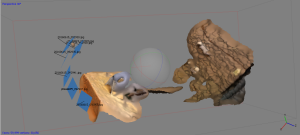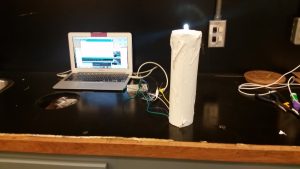This summer brings a “learning tour” of several one-week residencies to develop new ideas, context, and skills for Remix. First stop–Digital Humanities Summer Institute at the University of Victoria. As the start date drew close, I realized that I had mistakenly signed up for a course that requested that we bring “2 or 3 data sets to play with.” This instruction itself suggested that the week would not be successful–we have yet to create data that might submit itself to statistical analysis. DHSI organizers kindly let me move into another course that had open spaces, “Physical Computing and Desktop Fabrication” with Jentery Sayers, Tiffany Chan, Katherine Goertz, and Danielle Morgan of the Maker Lab. Since Remix investigates in part the interplay between a historical physical object (the fifteenth century manuscript) and its digital avatars, the opportunity to work with transformations between digital and physical forms sounded intriguing.
Throughout the week we worked on a wide variety of things, literally. Circuit boards, LEDs, wires, cardboard, 3D modeling software, photogrammetry, and more. My experiments in 3D modeling a book–yes, this is a book–were not successful:
Later I learned that 123D has a super app–thanks to Helen Davies–so maybe I’ll try again…
The goal for the week was to build something. I had the good fortune to be sitting near Mary Catherine Kinniburgh (Graduate Center, CUNY) and Marissa Yardley Clifford (Getty Museum) when this task came along. Their creativity with scissors and patience with programming made the whole process delightful–and successful! Our classmates built some amazing things: a gender-affirming bathroom handle, a world crisis signal structured with Egyptian pyramids, and much more.
We built a candle.
Well, I like to think of it as an epistemological intervention. Here’s a demonstration from Mary Catherine:
Final #physcomp project for #dhsi2016 with @MichelleRWarren + @YARD_LEY! an arduino candle! pic.twitter.com/JpH3BimWwW
— M.C. Kinniburgh (@mckinniburgh) June 18, 2016
A light sensor is attached that base, so that the LED at the top goes out when a shadow is cast. My favorite part was watching people interact with our unattended candle during the open forum on the last day. We thought that we had built a light sensing device but in fact it was a “learning style sensor.” Some people blew from just far enough away that they didn’t block the light: some shrugged and moved on, some moved closer to investigate. When it worked, some shrugged and moved on, some tried to figure out why, some laughed. Some people approached the table boldly, some hesitantly.
Some people suggested that “next time” we find a way to hide the sensor closer to the LED light. To me, though, the intrigue of the object lies in the fact that it disrupts the naturalized relation between our movements and their effects. The visual analogy between our device and a flame invites you to express air (reinforced by the written prompt “Please blow out the candle”). The air does nothing. The trick is to block the light, which might happen unintentionally even without blowing air. A more mimetic device would just be a bad candle.
What does this mean for Remix? A candle is a digital device (on or off) that operates along two analog spectra: light and air (each with a range of intensity). This description applies to both electronic and wax candles. As such, the analog/digital binary itself unravels a bit with a candle. This potential for epistemological crossover lies at the heart of digital manuscript studies. It’s the basis of mixology. Whether Remix gets more than philosophy out of physical computing remains to be seen.



Pingback: What is a Maker Space? An Invitation to Ours | GC Digital Fellows